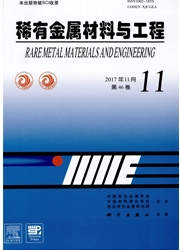

 中文摘要:
中文摘要:
采用籽晶浸渗生长工艺和定向凝固技术(DSIG)可以制备具有良好取向的单畴YBCO块材。利用Y-211颗粒和液相预制体作为初始材料以浸渗生长工艺可以控制Y-123基体上的Y-211颗粒的尺寸和分布并且可以制备出近终形的块材。讨论了籽晶定向浸渗生长工艺的主要参数(浸渗结构、温度梯度和最高加工温度)。另外,当液相为035时,Y-211颗粒掺杂的尺寸小于其它2种液相成分所得到的Y-211颗粒掺杂尺寸。
 英文摘要:
英文摘要:
The seeded infiltration-growth process is an alternative to replace conventional melt processing techniques for the preparation of bulk YBa2Cu3O7-σ (Y-123) with finely dispersed small size of Y2BaCuO5 (Y-211) particles. The directional solidification is also a quite effective technique to produce well-oriented cylinder grains. Well-oriented Y-123 bulks can be fabricated by combining seeded infiltration-growth and directional solidification technique (DSIG). The infiltration-growth process is able to control the size and distribution of Y-211 particles in the final Y-123 superconductor and can fabricate net-shape bulk. Y-211 particles and a liquid phase precursor. Were used as starting materials in the present investigation. The main parameters (temperature gradient, configuration and maximum processing temperature) of the directional seeded infiltration-growth process were discussed in the present paper. The result shows that Y-211 particle sizes upon using 035 liquid phase composition are smaller than those upon using other two liquid phase compositions.
 同期刊论文项目
同期刊论文项目
 同项目期刊论文
同项目期刊论文
 Analysis on the Ceasing Mechanism and Interface Morphology Evolution Rules of the YBCO Crystal Growt
Analysis on the Ceasing Mechanism and Interface Morphology Evolution Rules of the YBCO Crystal Growt Fabrication and Microstructure Characteristic of YBCO Bulk by Directional Top-Seeded Power Melting P
Fabrication and Microstructure Characteristic of YBCO Bulk by Directional Top-Seeded Power Melting P The effect of temperature gradient on the morphology of YBCO bulk superconductors by melt texture gr
The effect of temperature gradient on the morphology of YBCO bulk superconductors by melt texture gr The study on melting behavior of precursor powders for powder melting processed YBa2Cu3O7-x supercon
The study on melting behavior of precursor powders for powder melting processed YBa2Cu3O7-x supercon Analysis on the interface stability and morphology evolution rules of the YBCO crystal growth during
Analysis on the interface stability and morphology evolution rules of the YBCO crystal growth during 期刊信息
期刊信息
